Abstract
The architectural framework of the proposed system draws on an interactive interplay of a variety of system technologies that make up an integral whole of a single unit of a decision support system (DSS) for the retail industry. The DSS is solely a tool for decision-making for retail managers and draws from a variety of sources by capturing information and integrating it into the system. Typically, the system is modeled with a combination of an expert system (ES) with a web-based DSS that is linked to other support system components such as a knowledge base and database systems on the platform of internet hardware and software. Ajax-enabled knowledge object provides web interaction functionality. On the other hand, communication between the users who is the retail manager in this case is enabled through the use of graphical tools such as RIA. Mathematical modeling of the problems inherent in the retail industry due to competition and price optimization, besides the abilities, to make appropriate forecasting and other retail chain activities allow the problems to be expressed in symbols and other algebraic expressions to find the answer and make appropriate decisions. The paper looks at the architectural framework of a retail system that captures the use of software tools typically incorporating intelligence software to enable managers to make competitive decisions in the decision-making process.
Introduction
The architectural framework of the proposed decision support system (DSS) is an integration of various techniques, technologies and tools to support decision-making at the managerial level. Typically, the proposed system supports retail managers to make pricing decisions with appropriate product management in all aspects of product promotion, development, market analysis, real profit evaluations and projections, forecasting and revenue movement, price modifications, seasonal planning, competition, collaborations, and product price recommendations. The DSS in the retail environment achieves the functionality objectives by drawing on an architectural framework of subsystem components consisting of a model subsystem, a dialogue system, and a data subsystem. The mentioned subsystem components play significant roles with an accumulative approach to influencing the final decision outcomes. Empirical evidence shows that decision-making draws on the cognitive capabilities of the human brain and the interactive use of technology to allow the user to examine the preferences on decisions, available options, and uncertainties inherent in the retail marketing environment. Users interact with the DSS through a graphical user interface (GUI) with an intermediary technology providing the functionality of the communication component. Noteworthy, in theory, and practice, decision DSSs can be modeled on various decision-making models. One of the examples is the decision analytical model which draws on the probabilistic, analytical, and decision-making theories. In practice, decision-making problems will have to be solved through the interactive use of other technologies incorporated into the functionality of the proposed system typical of an e-business computerized architectural framework with artificial intelligence (AI) tools in decision making.
Conceptual framework of the proposed system
The proposed system is three layered architecture with the capability to support concurrent users at once.
The data layers provide data capture and storage facilities in several locations typical of the infrastructure of the whole system. On the other hand, the business domain provides access to the implementation of the rules and procedures that are typical of the retail marketing industry in decision making.
The architectural framework is theoretically and in practice integrated with the view layers incorporating the use of GUI tools. Typical examples include the RIA. RIA is a variant of XML and java technologies which have been developed on the Ajax technology applications.
Software portability and service are provided by the web based services which draw system functionality from web based components. The structure and development of the web based service components follow established standards and protocols and accommodate open standards of communication and other vendor requirements.
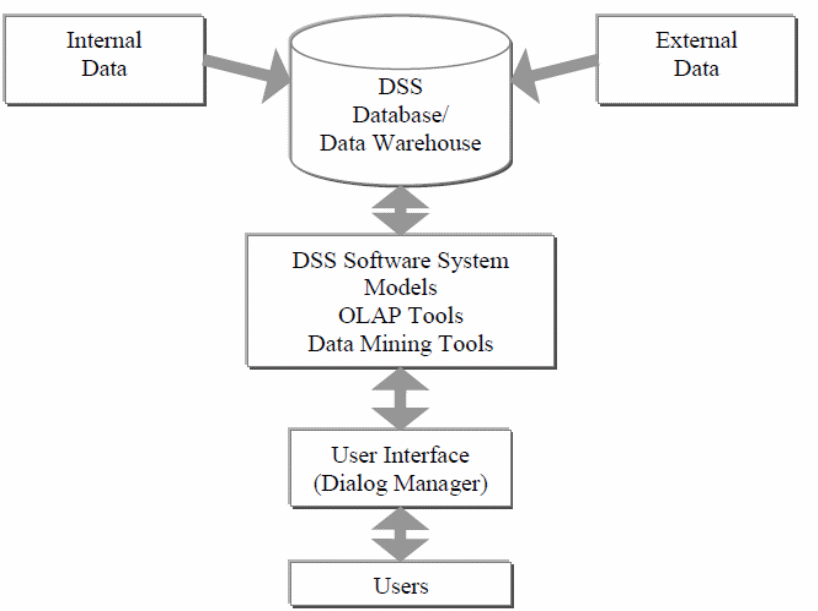
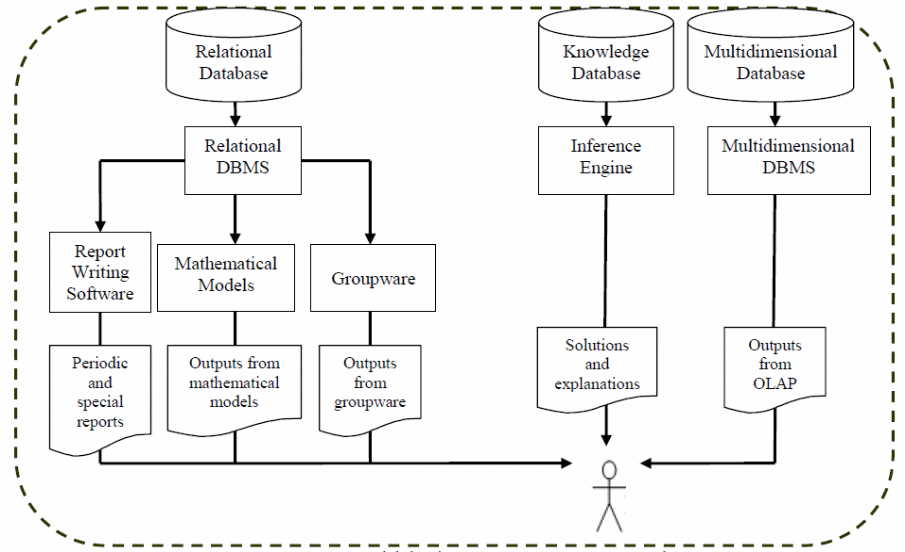

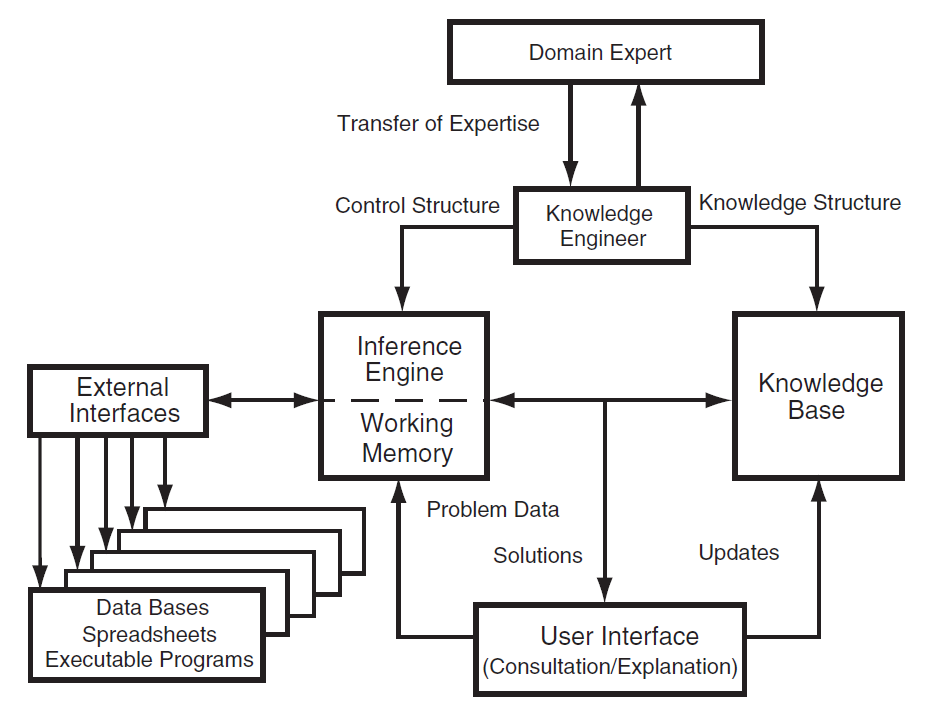
Integrated into the whole system is an expert system whose architecture is an inference engine, knowledge base, and working memory. In theory and practice, the expert engine draws on human expert knowledge while the working memory draws on data bases and other tools such as spread sheets (Chau, 1995).
All the information stored and retrieved can be captured using web based tools specific to the retail systems.
The working memory varies dynamically and reflects problems due to pricing, group pricing, forecasting, sales profits, revenue generation, and marketing information. Web based tools provide current and real time information that updates the working memory with the current situation in the market (Sage, 1991).
Other components in the system are graphically displayed and the diagram takes one through the functionalities of each component (Chau, 1995).
To fulfill the architectural framework of the proposed retail system, interactive components of the architectural design of the system are illustrated above.

An agent enables communication between the components which is theoretically exemplified below.
Data Warehouse
Provides a repository of data and information that can be captured from the internet using web based tools such as OLAP and on the Ajax platform.
DSS Software model
DSS software model incorporate tools such as OLAP and GDS in decision making. To model incorporates knowledge management tool as part of the decision making tool (Sage, 1991).
Relational database
The relational database is queried to provide information about the status of sales, real time profits, and to provide input data to the appropriate software for forecasting and making other pricing decisions (Sage, 1991).
Relational DBMS
The RDBMS plays the role of an integral component of the reports, mathematical models, and groupware software.
Report Writing Software
Use to generate reports that are generated due to sales and other retail marketing operations.
Mathematical Models
Typically, the knowledge used in decision making are expressed in mathematical symbols and expressions and at times expressed in probabilistic terms. Eventually, statistical approaches are used such as the use of reliability analysis and other mathematical approaches to make appropriate decisions on pricing and to solve other retail based problems (Chau, 1995).
Group Ware
Group ware provides user particularly users who are spread on a wide geographic area typical of the retail industry. Several stores are situated and spread widely and the use of group ware software will provide a powerful tool for collaborations over the internet based on web based technologies. Various collaboration software tools are available in the market and a thorough evaluation and selection criteria should be conducted against established benchmarks.
Knowledge Database
The knowledge base provides a storage of information with gained through continued learning. Typically, the knowledge base allows the retail manager to retrieve data and information for the intelligence software to allow decision making based on the learning curve (Chau, 1995).
Inference Engine
The inference engine uses production rules in decision-making and incorporates an intelligence software tool to that end.
Periodic and Special Reports
The reports are presented graphically such as the use of spreadsheets and other graphical tools.
Output from Mathematical Models
Provides mathematical solutions to problems using mathematical methods and allows the use of operational research techniques to perform financial analysis of the operations of the retail outlets. Both decision making environments which include certainty and uncertainties are factored in the process (Li, Daun, Kinman & Edwards, 1999).
Multidimensional database
Provides access to the RDBMS systems where Linux provides an excellent platform for affecting the system and Windows XP allows for smooth interoperability.
Multidimensional DBMS
Typical examples include Linux’s Linas Vepsta tools that incorporate middleware that provides the functionality of interfacing with the web based databases and servers. Perl is one of the languages used in the environment (Li, Daun, Kinman & Edwards, 1999).
Output from OLAP
OLAP is one of the data analysis tools used in the analysis of captured data in the retailing business.
Problem identification of decision support systems in the retail industry
An aggregate whole of the functional components of the decision support system (DSS) for the retail outlet are in theory modeled mathematically to run under the full functionality of the system components to allow users in problem identification phases.
Montgomery (2005) emphasizes that decisions making for promotional prices for multiple stores with a multitude of products can only be optimized by the use of the integral components of the DSS to be a typical problem for the retail environment. Typically, the software components have to allow for moving averages to be established using the underlying trends for a number of periods with significant randomness.
In practice, as exemplified in fig 1 above, the knowledge object will incorporate the use of the software tool to search for suitable knowledge objects in a repository. Through the use of an appropriately configured graphical user interface (GUI), the retail manager will enter appropriate data to narrow the search for the right object. Further, closest fitting knowledge objects are then identified and created to fit into the solution space. The problem description and the closest fitting knowledge object are then stored in the repository which is a web enabled DSS, and the learning process for the retail manager continues (Boreisha & Myronovych, n.d).
Requirements of a decision support system for retailing
Montgomery (2005) details typical system requirements for a DSS required to fulfill the object and functionality of a retail supermarket industry. The DSS offers knowledge based decisions based on the integral system and sub-system components.
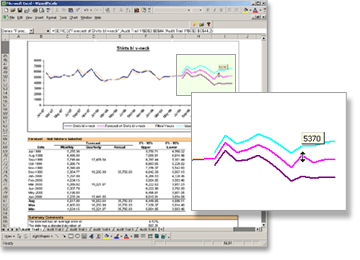
Choices and Justification of decision support
In selecting the appropriate tool to use for the DSS in the retail environment, the following tabulations provide actual functionalities typical of the system in the specific areas of the DSS functionalities.
The interactive use of the components in decision making is illustrated in the following diagram.
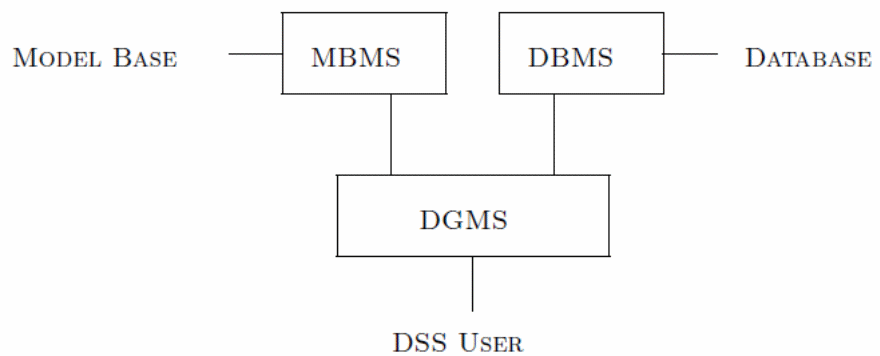
Problems Solution Based on PBL
The practical approach of identifying the problem in the retail environment is based on a theoretical model illustrated in the diagram below.
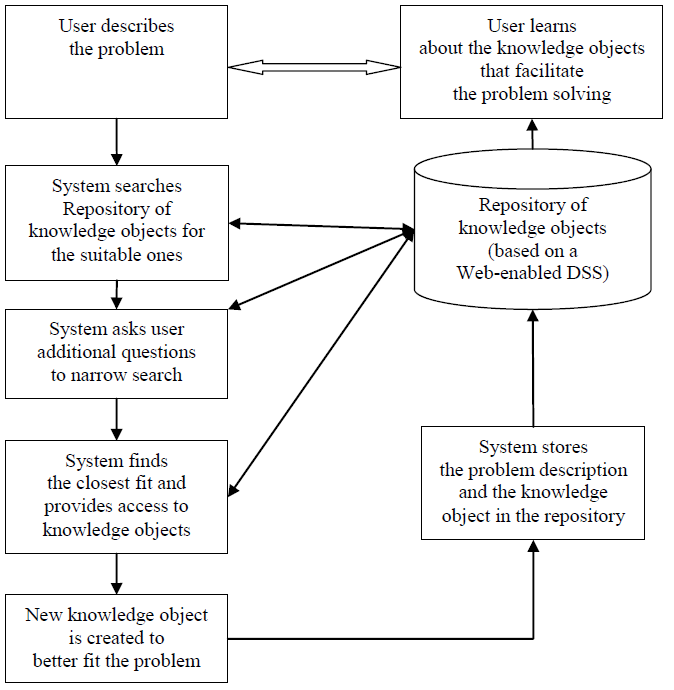
The user will have to formulate the problem to the specific requirements of the functionality of the system to enable the system understand the user’s need in the language of the software product in use, using a knowledge object which is an integral component of the system. The underlying theory of problem identification and solution seeking in the retail environment is continued learning by knowledge acquisition through web based agents that capture information, store the information in a repository or database to be manipulated for use in decision making. In theory and practice, all the phases are typical of a learning system (Chau, 1995). A typical example is the interactive role of the Ajax-enabled application which provides the interactive functionality with the web services through a software communication component. Typically, the Ajax enabled application’s interactive role is exemplified below.
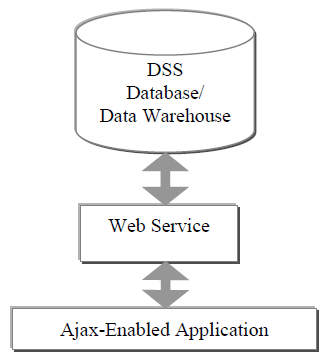
In practice, the DSS will allow the retail managers to identify and set appropriate and competitive prices and promotions by managing a whole range of a variety of products in different store locations. Typically, the number of items involved in the retail system will demand millions of decisions. In theory, expert knowledge in decision making draw on the human brain which is sometimes inherently characterized by the weakness and bias of the mind in decision making. Therefore the need to incorporate the use of software technologies to enable real time calculations in making quantitative and qualitative forecasting on product pricing becomes all more important (Li, Daun, Kinman & Edwards, 1999).
Conclusion
The proposed decision support system is a technological approach to solving identifiable problems typical of the retail marketing industry. The decision support system enables retail managers to make decisions on appropriate pricing for the wares that are the sole business functions of the retail outlet. Typically, the functionality of the system is based on software tools that work in collaboration towards achieving the goals in decision making. Typically, the DSS architecture is web based and consists of collaborating software tools that work interactively towards a common goal. Such system components include the knowledge object, DBMS, RDBMS, MDMS, GUI, and expert systems on a web based architecture. The tools are used to capture information draw on a problem learning based on the captured information to enabler retail managers make appropriate decisions for pricing, price predictions, revenue generation, promotions, and marketing strategies.
References
Boreisha, Y., & Myronovych, O., n.d. Web-Based Decision Support Systems As Knowledge Repositories for Knowledge Management Systems. New York: Las Vegas.
Chau, P. Y. K., 1995. Factors used in the selection of packaged software in small Businesses: Views of owners and managers. Information & Management. 29, 71-78.
Li, S., Daun, Y., Kinman, R., & Edwards J., S., 1999. A framework for a hybrid intelligent system in support of marketing strategy development. Marketing Intelligence & Planning. 17, 209-216.
Montgomery, A.L., 2005. The implementation challenge of pricing decision support systems for retail managers. Applied Stochastic Models in Business & Industry, 21(4/5), pp-367-378.
Sage, A.p.,1991. Decision Support Systems Engineering. New York: John Wiley & Sons, Inc.